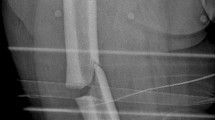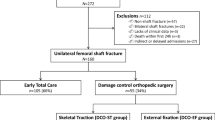Summary
Primary intramedullary nailing of femoral fractures is well known to increase the risk of pulmonary complications, especially in multiple-trauma patients with severe thoracic injuries. Aim of this study was to investigate the influence of primary plate ostesynthesis of femur fractures on maior complications after trauma. This retrospective study based on the records of 325 multiple trauma patients (Injury severity score ISS > 18, no letal brain injury, age 16–65). According to the abbreviated injury scale of the Thorax (AIS T) patients were divided in groups without (AIS T < 3, “N”) or with relevant thoracic injury (AIS T > = 3, “T”). Both groups were additionally divided in subgroups without severe trauma to the extremities (AIS E< 3, “0”) or primary plate-osteosynthesis of femur fractures (< 24 h, “I”). 4 groups were performed: N0 (n = 39, ISS 25 ± 1, pneumonia 10 %, ARDS 5 %, lethality 10 %); NI (n = 55, ISS 27 ± 1, pneumonia 4 %, ARDS 5 %, lethality 4 %); T0 (n = 137, ISS 28 ± 1, pneumonia 21 %, ARDS 15 %, lethality 16 %); TI (n = 94, ISS 31 ± 1, pneumonia 21 %, ARDS 17 %, lethality 15 %). Primary plate-osteosynthesis of femur fractures did not increase lethality or incidence of pulmonary complications in patients with or without severe thoracic injuries. Also complication rate after primary plate-osteosynthesis was less compared to published results after intramedullary nailing. For this, primary plate-osteosynthesis is recommendable in case of multiple trauma with thoracic injuries.
Zusammenfassung
Bei polytraumatisierten Patienten mit Femurfraktur wird bei primärer gebohrter Marknagelosteosynthese mit einer höheren Inzidenz von pulmonalen Komplikationen gerechnet, insbesondere bei begleitendem schweren Thoraxtrauma. Mit dieser Studie sollte der Einfluß der primären Oberschenkelplattenosteosynthese auf den Verlauf nach Trauma untersucht werden. 325 Patienten mit einer Verletzungsschwere im „Injury Severity Score“ (ISS) über 18 Punkte, ohne letales Schädel-Hirn-Trauma und einem Alter von 16–64 Jahre wurden in die retrospektive Studie eingeschlossen. Anhand der regionalen Verletzungsschwere im „Abbreviated Injury Scale des Thorax“ (AIS T) wurden diese Patienten in eine Gruppe ohne (AIS T < 3, „N“) bzw. mit Thoraxtrauma (AIS T > = 3, „T“) eingeteilt. Diese Gruppen wurden unterteilt in eine Gruppe ohne schweres Extremitätentrauma (AIS E < 3, „0“) und eine Gruppe mit Oberschenkelfraktur und primärer (< 24 h, „I“) Plattenosteosynthese des Femur, wodurch 4 Gruppen entstanden: N0 (n = 39, ISS 25 ± 1, Pneumonie 10 %, ARDS 5 %, Tod 10 %); NI (n = 55, ISS 27 ± 1, Pneumonie 4 %, ARDS 5 %, Tod 4 %); T0 (n = 137, ISS 28 ± 1, Pneumonie 21 %, ARDS 15 %, Tod 16 %); TI (n = 94, ISS 31 ± 1, Pneumonie 21 %, ARDS 17 %, Tod 15 %). Die primäre Plattenosteosynthese führte weder bei Patienten mit, noch bei Patienten ohne relevantes Thoraxtrauma zur Erhöhung von Letalität oder Morbidität. Im Gegensatz zu mitgeteilten Ergebnissen nach Oberschenkelmarknagelung ist die Plattenosteosynthese als definitives und komplikationsarmes Verfahren gerade bei polytraumatisierten Patienten mit schwerem Thoraxtrauma zu empfehlen.
Similar content being viewed by others
Author information
Authors and Affiliations
Rights and permissions
About this article
Cite this article
Aufmkolk, M., Neudeck, F., Voggenreiter, G. et al. Influence of primary plate-osteosynthesis of femur fractures on complications in multiple trauma patients with or without thoracic injuries. Unfallchirurg 101, 433–439 (1998). https://doi.org/10.1007/s001130050292
Published:
Issue Date:
DOI: https://doi.org/10.1007/s001130050292




